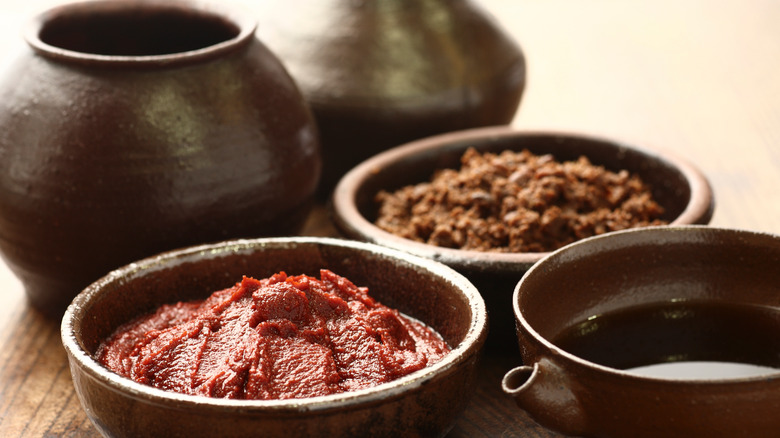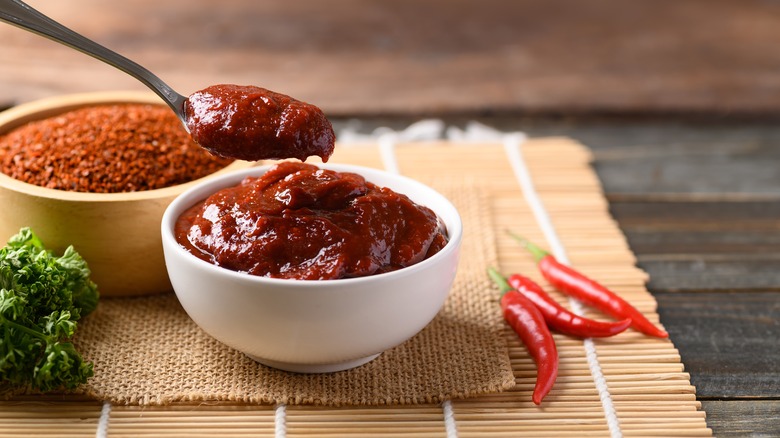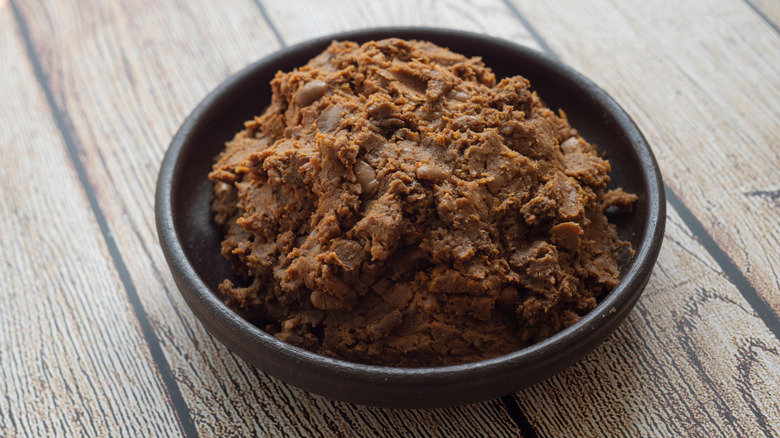Gochujang Vs. Doenjang: What's The Difference?
Korean cuisine is rich with history and culture, as well as unique and complex, fresh flavor profiles. As Arirang Korean BBQ explains, Korean food is influenced by the yin-yang concept of balance, meaning all dishes have balanced taste and nutritional benefits, meant to maintain both your physical and mental health.
Anyone familiar with Korean cuisine knows how complex the flavors are, with an emphasis on highlighting and amplifying fresh ingredients. These ingredients are paired with staple seasonings, like vinegar, gochugaru (red chili flakes), fresh garlic, sesame oil, anchovies, and more (via My Korean Kitchen).
Two of the most important pantry staples in Korean cuisine, though, are gochujang — red chili paste — and doenjang, or fermented soybean paste. These two pastes are used in a plethora of famous Korean dishes, from tteokboki and kimchi jjigae to ssamjang and bossam. Those unfamiliar with Korean cuisine may not understand the differences between the two pastes from the outside, but they offer two very distinct flavor profiles and have varied, but equally important, uses in Korean cooking.
Gochujang
Gochujang is very easily identifiable by its rich, vibrant red color. As Chef's Society explains, gochujang's primary ingredient is red chili flakes, as well as glutinous rice, fermented soybeans, and salt, all of which are aged and fermented for multiple years in earthenware. The end result is something that is primarily spicy and salty, as well as sweet from the rice's fermented sugars, and rich in umami flavors from the soybeans, hitting almost all five flavor elements in one paste.
A little goes a lot with gochujang, the bold flavors usually used in the preparation of a meal as opposed to on the side or top, unlike other hot sauces. The deep flavors are particularly stunning in stewed dishes, including kimchi jjigae, dakbokkeumtang, or bibimbap (via Korean Bapsang).
Gochujang is also often one of the starring ingredients in barbeque marinades and sauces — mostly added to beef and grilled. It's also used in the sauce for Korean fried chicken, which is also called candy chicken due to the sauce's complex, sweet hot sauce, which owes a great deal of its flavor components to gochujang (per Visit Korea). One of the most popular Korean dishes, tteokbokki, is made of rice cakes simmered in a gochujang sauce.
Doenjang
Doenjang is also a fermented paste, made out of soybeans, and dates back as far as the 3rd century, according to Carving a Journey, unlike gochujang, which only dates back to the 15th century. Making doenjang is a long process, which starts with soaking and boiling soybeans in salt water, which are then ground down and mashed into cubes called meju. The meju is dried and hardened, the length of time and extent varying region by region.
The meju is then aged in brine in an earthenware pot, often with added chilis, charcoal, or other flavor-boosting ingredients. Once fermented, the liquid turns into soy sauce, and the paste becomes doenjang. This may sound similar to miso paste, but the key difference is that miso paste is fermented with grains like rice (per MasterClass).
Doenjang is very rich in umami flavors and can be quite pungent to people using it for the first time. It has a similar effect as fermented or aged cheeses. The soybean paste is also very salty. Doenjang is the star of deonjang jjigae, a soup that uses doenjang essentially as a bouillon cube, adding it to a pot of water, vegetables, and tofu for a flavorful, earthy dish. It's also used in ssamjang, which is a dipping sauce used for ssam, or Korean lettuce wraps. Ssamjang is a sweet, salty, slightly spicy sauce usually made out of doenjang, gochujang, honey, sesame oil, garlic, and onion, notes Maangchi.


